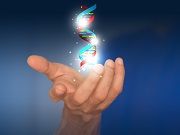Article
'First Responder' Protein Finds DNA Damage
Author(s):
A unique pattern of motion by repair proteins allows them to rapidly scan long DNA and flag repair machinery in condition that can lead to skin cancer.

How a repair protein, Rad4, identifies and scans for damage in DNA was revealed in a new study published in Molecular Cell.
“Rad4 is like the cop who is the first responder at an accident,” said senior study author Bennett Van Houten, PhD. “The cop can move quickly to recognize where the incident is, and regulate traffic while directing the paramedics arriving in an ambulance.”
By scanning DNA in a unique constrained motion, it allows Rad4 to be fast enough to scan large lengths of DNA quickly, but slow enough that it doesn’t miss any structural errors in DNA that could be caused by UV light or chemicals.
Mutations in Rad4, called XPC, and other proteins in the DNA repair machinery, are known to cause a genetic condition called xeroderma pigmentosum. This disease causes individuals to be sensitive to sunlight, and are at an extremely high risk for developing skin cancer.
In the study, researchers tagged both normal and mutant Rad4 molecules with light-emitting quantum dots so that they could observe the molecules moving across strands of DNA that were suspended between beads using a fluorescence microscope.
The study’s findings suggest that the first responder, Rad4 and Rad23, quickly scans DNA for accidents by attempting to bend it. Alterations in the structure of DNA, change the ease in which DNA can be bent, according to the study.
When a potential accident is found, the Rad4-Rad23 first-responder team slows down to a constrained motion pattern so that they can more carefully examine a smaller region of 500 to 1000 base pairs of DNA.
If the structural damage is confirmed, the first-responder team will stay near the area and flag down the rest of the DNA repair machinery to fix the damage. Researchers called this mechanism “recognition-at-a-distance” and it allows the Rad4 to be near the damage without blocking the repair crew.
The study authors noted that more research needs to be done, but their findings may lead to cancer therapies that boost existing drug treatments and stop drug-resistance.






